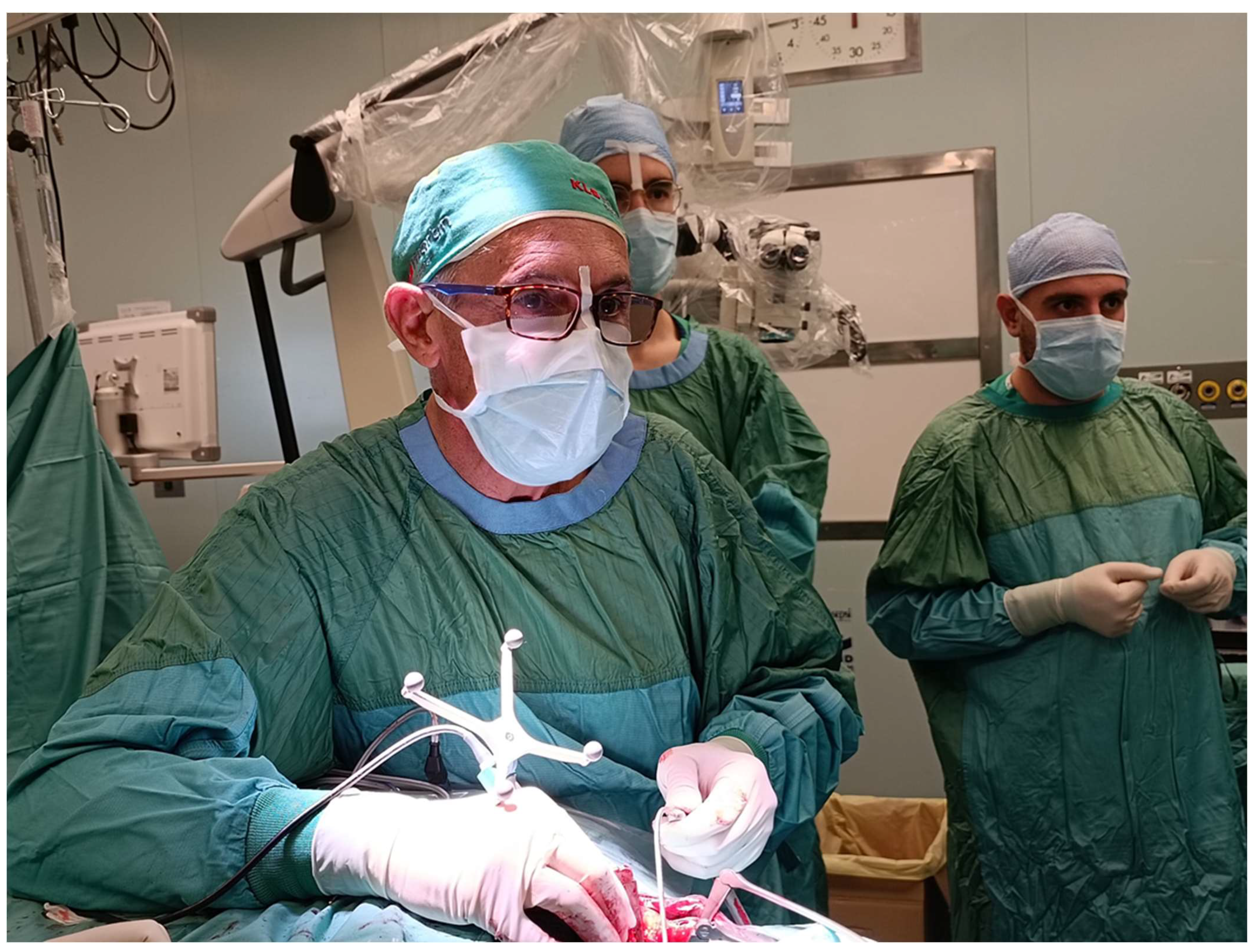Neurosurgery and Spine Surgery: From Up-to-Date Practitioners, From the Past to the Present
Funding
Conflicts of Interest
References
- Visocchi, M. Why the Funnel in Neurosurgery? Acta Neurochir. Suppl. 2023, 135, 1–3. [Google Scholar] [CrossRef] [PubMed]
- Visocchi, M. Reconstructive Neurosurgery: A Challenge. Acta Neurochir. Suppl. 2017, 124, 1–4. [Google Scholar] [CrossRef] [PubMed]
- Visocchi, M.; Mattogno, P.P.; Ciappetta, P.; Barbagallo, G.; Signorelli, F. Combined transoral exoscope and OArm-assisted approach for craniovertebral junction surgery: Light and shadows in single-center experience with improving technologies. J. Craniovertebr Junction Spine 2020, 11, 293–299. [Google Scholar] [CrossRef] [PubMed]
- Visocchi, M.; Mattogno, P.P.; Signorelli, F. Exoscope and OArm: What we can learn in craniovertebral junction surgery. J. Neurosurg. Sci. 2021, 65, 616–617. [Google Scholar] [CrossRef] [PubMed]
- Visocchi, M.; Masferrer, R.; Sonntag, V.K.; Dickman, C.A. Thoracoscopic approaches to the thoracic spine. Acta Neurochir. 1998, 140, 737–743. [Google Scholar] [CrossRef] [PubMed]
- Visocchi, M. Why the Craniovertebral Junction? Acta Neurochir. Suppl. 2019, 125, 3–8. [Google Scholar] [CrossRef] [PubMed]
- Meglio, M.; Cioni, B.; Visocchi, M. Cerebral Hemodynamics During Spinal Cord Stimulation. Acta Neurochir. Suppl. 1991, 14, 127–130. [Google Scholar] [CrossRef] [PubMed]
- Visocchi, M.; Della Pepa, G.M.; Esposito, G.; Tufo, T.; Zhang, W.; Li, S.; Zhong, J. Spinal cord stimulation and cerebral hemodynamics: Updated mechanism and therapeutic implications. Stereotact. Funct. Neurosurg. 2011, 89, 263–274. [Google Scholar] [CrossRef] [PubMed]
- Della Pepa, G.M.; Fukaya, C.; La Rocca, G.; Zhong, J.; Visocchi, M. Neuromodulation of vegetative state through spinal cord stimulation: Where are we now and where are we going? Stereotact. Funct. Neurosurg. 2013, 91, 275–287. [Google Scholar] [CrossRef] [PubMed]
- Certo, F.; Altieri, R.; Maione, M.; Schonauer, C.; Sortino, G.; Fiumanò, G.; Tirrò, E.; Massimino, M.; Broggi, G.; Vigneri, P.; et al. FLAIRectomy in Supramarginal Resection of Glioblastoma Correlates With Clinical Outcome and Survival Analysis: A Prospective, Single Institution, Case Series. Oper. Neurosurg. 2021, 20, 151–163. [Google Scholar] [CrossRef] [PubMed]
- Certo, F.; Stummer, W.; Farah, J.O.; Freyschlag, C.; Visocchi, M.; Morrone, A.; Altieri, R.; Toccaceli, G.; Peschillo, S.; Thomè, C.; et al. Supramarginal resection of glioblastoma: 5-ALA fluorescence, combined intraoperative strategies and correlation with survival. J. Neurosurg. Sci. 2019, 63, 625–632. [Google Scholar] [CrossRef] [PubMed]
- Barbagallo, G.M.; Maione, M.; Peschillo, S.; Signorelli, F.; Visocchi, M.; Sortino, G.; Fiumanò, G.; Certo, F. Intraoperative computed tomography, navigated ultrasound, 5-amino-levulinic acid fluorescence and neuromonitoring in brain tumor surgery: Overtreatment or useful tool combination? J. Neurosurg. Sci. 2024, 68, 31–43. [Google Scholar] [CrossRef] [PubMed]


Disclaimer/Publisher’s Note: The statements, opinions and data contained in all publications are solely those of the individual author(s) and contributor(s) and not of MDPI and/or the editor(s). MDPI and/or the editor(s) disclaim responsibility for any injury to people or property resulting from any ideas, methods, instructions or products referred to in the content. |
© 2024 by the author. Licensee MDPI, Basel, Switzerland. This article is an open access article distributed under the terms and conditions of the Creative Commons Attribution (CC BY) license (https://creativecommons.org/licenses/by/4.0/).
Share and Cite
Visocchi, M. Neurosurgery and Spine Surgery: From Up-to-Date Practitioners, From the Past to the Present. J. Clin. Med. 2024, 13, 5840. https://doi.org/10.3390/jcm13195840
Visocchi M. Neurosurgery and Spine Surgery: From Up-to-Date Practitioners, From the Past to the Present. Journal of Clinical Medicine. 2024; 13(19):5840. https://doi.org/10.3390/jcm13195840
Chicago/Turabian StyleVisocchi, Massimiliano. 2024. "Neurosurgery and Spine Surgery: From Up-to-Date Practitioners, From the Past to the Present" Journal of Clinical Medicine 13, no. 19: 5840. https://doi.org/10.3390/jcm13195840



